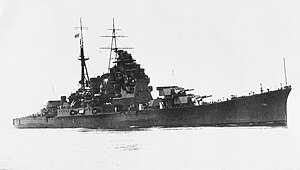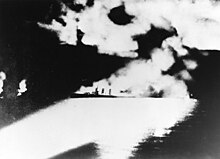Japanese cruiser Chōkai
This article needs additional citations for verification. (February 2023) |
 Chōkai in 1933
| |
| History | |
|---|---|
| Name | Chōkai |
| Namesake | Mount Chōkai |
| Builder | Mitsubishi |
| Laid down | 26 March 1928 |
| Launched | 5 April 1931 |
| Commissioned | 30 June 1932 |
| Stricken | 20 December 1944 |
| Fate | Scuttled after gunfire/bomb damage in Battle off Samar, 25 October 1944 |
| General characteristics | |
| Class and type | Takao-class cruiser |
| Displacement | 15,781 tons |
| Length | 203.76 m (668.5 ft) |
| Beam | 19 m (62 ft) |
| Draught | 6.3 m (21 ft) |
| Propulsion | 130,000 hp (97,000 kW) |
| Speed | 35.5 knots (65.7 km/h) |
| Range | 8,000 nautical miles (15,000 km) at 14 knots (26 km/h) |
| Complement | 773 |
| Armament |
|
| Aircraft carried | 2 |
| Aviation facilities | catapult |
Chōkai (鳥海) was a
Chōkai participated in numerous actions during the Pacific War including the Battle of Savo Island off Guadalcanal, in which she along with other Japanese cruisers, sunk the heavy cruisers USS Astoria, USS Vincennes and USS Quincy. She was sunk in the Battle off Samar in October 1944.
Design

The Takao-class cruisers were an improved version of the previous Myōkō-class design, incorporating technical elements learned with the development of the experimental light cruiser Yūbari. They had a distinctive profile with a large, raked main smokestack, and a smaller, straight, second smokestack. Intended to address issues with the Myōkō class, the Takao class had thicker armor, dual-purpose main guns which could be used against aircraft, and torpedo launchers moved to the upper deck for greater safety. However, as with its predecessors, the Takao class was also top-heavy.[1]
The Takao class displaced 16,875 t (16,608 long tons). Chōkai was 203.8 metres (669 ft) long, with a beam of 20.4 metres (67 ft), draft of 6.32 metres (20.7 ft) and was capable of 35.25 knots.[1]
Propulsion was by 12
Chōkai's main battery was ten
Operational history

At the start of the Pacific War, Chōkai supported the invasion of Malaya and participated in the pursuit of the Royal Navy's battleship Force Z. During January and February 1942, Chōkai was involved in operations to seize the oil-rich Dutch East Indies and the island of Borneo. Steaming near Cape St. Jacques, Chōkai struck a reef, sustaining hull damage on 22 February 1942. On 27 February, she reached Singapore for repairs.
After repairs, Chōkai was once again assigned to a support role in an invasion, this time the landings at

On 1 April 1942, Chōkai left Mergui to participate a raid on merchant shipping in the Bay of Bengal. First, Chōkai torpedoed and sank the U.S. freighter Bienville, and later on, the British steamship Ganges on 6 April. With her role in the operation successfully concluded, Chōkai returned to Yokosuka on 22 April 1942.
Battle of Savo Island

By mid-July 1942, Chōkai was made the new flagship of
Subsequent action
Relieved as the Eighth Fleet flagship shortly after the final evacuation of Guadalcanal, Chōkai headed back to Yokosuka on 20 February 1943. Tasked with various minor duties for the remainder of 1943 and first half of 1944, Chōkai was made the flagship of the Cruiser Division Four ("CruDiv 4") comprising Takao, Maya, Atago, and Chōkai on 3 August 1944. All four ships took part in the Battle of the Philippine Sea.
Battle of Leyte Gulf

CruDiv 4 was part of Admiral Takeo Kurita's large fleet of IJN battleships, cruisers, and destroyers that took part in the various engagements of the Battle of Leyte Gulf at the Philippines.
CruDiv 4 suffered a harrowing submarine attack on 23 October 1944, with the sinking of Maya and Atago (which was Kurita's flagship though he survived), while Takao was left permanently crippled, leaving Chōkai as the only undamaged ship of CruDiv 4.
Chōkai was then transferred to Cruiser Division Five, where she survived an air attack on 24 October 1944, while the battleship Musashi was sunk.
Sunk in the battle off Samar
On the morning of 25 October, Chōkai engaged an American force of
Wreck
Chōkai sits upright in 5,173 metres (16,972 ft) of water on the edge of the Philippine Deep. RV Petrel discovered the wreck of Chōkai on 5 May 2019 and dived it via ROV on 30 May 2019.
References
- ^ a b c d Patton, Japanese Heavy Cruisers of World War Two, pp. 36–48
- ISBN 978-0140165616.
- ISBN 978-0316583053.
- ISBN 978-0-553-38148-1.
- ^ Hackett, Bob; Sander Kingsepp (2018). "IJN Chokai: Tabular Record of Movement". Junyokan!. www.combinedfleet.com. Retrieved 8 August 2019.
- ^ "H-060-3 The Search for USS Johnston". H-Gram. Naval History and Heritage Command. 20 April 2021.
Petrel also found the Japanese heavy cruiser Chokai
- ^ IJN Chokai. RV Petrel. 25 October 2019 – via Facebook.
Bibliography
- Dull, Paul S. (1978). A Battle History of the Imperial Japanese Navy, 1941–1945. Naval Institute Press. ISBN 0-87021-097-1.
- Lacroix, Eric; Linton Wells (1997). Japanese Cruisers of the Pacific War. Naval Institute Press. ISBN 0-87021-311-3.
- Thorne, Phil (2001). "Re: Fate of Chikuma and Chokai". Warship International. XXXVIII (2). International Naval Research Organization: 114–115. ISSN 0043-0374.
